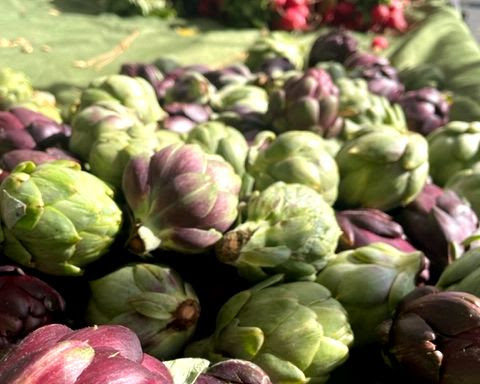Produce Spotlight: Artichokes are Here!
Artichokes may look like they don’t want to be eaten, but they’re actually quite easy to prepare and oh-so-versatile! The work is definitely worth the labor when it comes to these little guys, but they are only around for a short time in spring. There are two types of artichokes that we see here; the globe artichoke, which is the large one, and baby artichokes, which are fully-grown but around the size of a golf ball. Baby artichokes are great because they can be trimmed and eaten whole. If you get to know the lay of the artichoke land and get past the spiky tips, you’ll find they are mild-flavored but delicious, and can be used in so many ways!
To pick a good artichoke, the leaves should be thick, tightly closed and have a vibrant, deep green color. They should squeak when you rub them together. Avoid artichokes that have opened, dry or split leaves. Generally, the smaller the artichoke, the more tender and sweet it will be. However, larger artichokes will have larger hearts and the hearts are the sweetest part of the artichoke.
If you’ve never had a fresh artichoke (gasp) or just don’t know what the heck to do with them, keep reading for tips and tricks, and then get down to the Chico Certified Farmers’ Market and scoop some up – they’ll probably only stick around through May!
- art4
- art5
Make the Most of your Chokes!
Preparing Artichokes for use (the time consuming part):
1. Rinse the artichokes in cold water to get out any grit that is between the leaves.
2. Prepare a large bowl of cold water with the juice of a lemon squeezed into it.
3. Use a sharp knife to cut off the stem so the artichoke can stand flat. If you want to keep it on, make sure to trim and peel it. Cut about 1 inch off the top of the artichoke. Snap off any tough, dry leaves around the stem area. Using kitchen shears, trim about ¼ to ½-inch off the thorny leaf tips. Leave the artichoke whole if you plan to steam it or stuff it. If you are cooking it other ways, it’s a good idea to cut the artichoke in half lengthwise.
Removing the “choke.” The choke is a bundle of white and purple leaves and below those leaves is a bed of hairy-looking filaments. The choke can be removed before or after steaming the artichokes. Remove the inner sharp leaves in the center and scrape out the center fuzzy choke with a spoon, paring knife or melonballer. After you remove the choke, you will have reached the heart which you can cut into pieces and eat or use in a variety of recipes. Submerge the artichoke into the lemon water while you prepare the rest of them and until ready to cook.
- Unless you’re going to braise or roast them, it’s best to boil or steam them before using in other recipes (such as grilling). But, if you shave them thin, you can eat them raw in salads!
- Wearing latex gloves is recommended if you have them. While not essential, the gloves keep your skin free of the artichoke’s bitter raw fluids, which have a way of tainting any other food you touch after handling the artichokes.
- Don’t skip the lemon water! Acidulated water slows down browning due to oxidation! You can also rub lemon on any cuts parts to prevent browning.
With these basic facts, you can go forth and start your artichoke adventures. Or, for a fantastic, in depth article (complete with step by step photos), click here!
- art3
- art1




